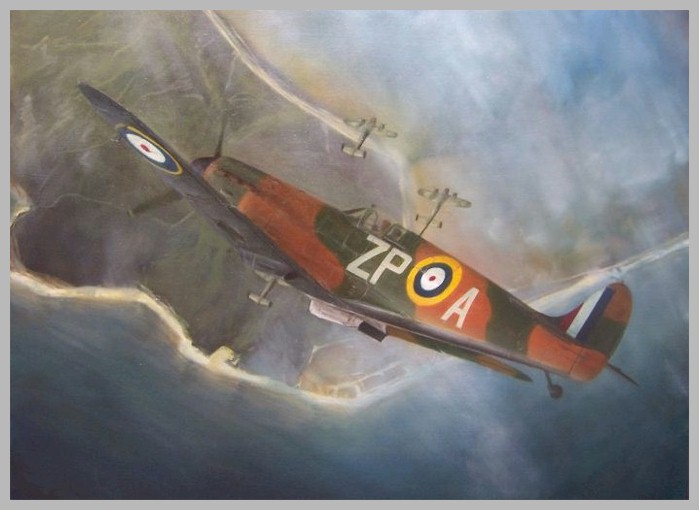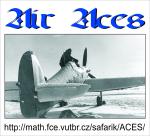
TIGERS STRIKE
Supermarine Spitfire Mk.I, , "ZP-A", No. 74 Fighting Squadron RAF,
13th October 1940, pilot Sqn A.G. "Sailor" Malan
original painting in personal collection

TIGERS STRIKE
Supermarine Spitfire Mk.I, , "ZP-A", No. 74 Fighting Squadron RAF,
13th October 1940, pilot Sqn A.G. "Sailor" Malan
original painting in personal collection
|
Adolph Gysbert Malan was born on October 3rd 1910 in Wellington, South Africa. By the age of 14 he was a sea cadet on the training ship General Botha and then joined the Union Castle Steamship Line in 1927
After the outbreak of war, Malan went into action with 74 Squadron, with their newly equipped Spitfires, over the beaches of Dunkirk. On May 21 1940 he scored his first victories just off the coast at Dunkirk destroying a Ju88, a He111 and damaged another Ju88. On May 22nd he shared the destruction of a Ju88, on the 24th he shared a Do17 and destroyed a He111. On May 27th during his last combat over Dunkirk he shot down a Bf109, shared a Do17 and damaged two more For his action Malan was awarded the DFC on June 11th 1940 and a week later during a night operation on June18th, he shot down two He111’s As the first phase of the Battle of Britain got underway, Malan shared the destruction of a He111 on July 12th, scored a probable victory on a Bf109 on July 19th, damaged a Bf109 on July 25th and shot down a Bf109 and damaged a second on July 28th It was during this early period of the battle that Malan, famously, disregarded the “textbook” formations and tactics of aerial combat. He firstly ordered that the machine guns on his Spitfire be re-aligned to a shooting distance of 250 yards, instead of the recommended 400 yards. He abandoned the “3 aircraft Vic” formation for a more unconventional four aircraft in-line attack. Within his squadron, Malan issued his unofficial “Ten Commandments” of aerial fighting Although Malan did not conform to the official “system”, he carried much respect from higher authority right up to and including Winston Churchill. He regularly discussed battle tactics with Air Vice Marshall Keith Park (AOC of 11 Group) and although he did not fully believe in Bader’s “Big Wing” theory, Malan did urge Park to allow the formation of these squadrons to be assembled by 12 Group north of London During August he was given command of 74 Squadron on the 8th, shot down two Bf109’s, damaged a third on the 11th and shot down two Do17’s on the 13th. His victories continued into the conflict when he shot down a Ju88 and damaged another on September 11th, claimed a probable Bf109 on October 17th and destroyed a Bf109 on October 22nd On November 23rd he shot down a Bf109, then destroyed a Bf109 and shared another on November 27th. Malan shot down another Bf109 on December 2nd a few weeks before he was awarded the DSO on Christmas Eve Malan scored his last victories for 74 Squadron in February 1941 when he shot down a Bf109 on the 2nd and shared a Do17 on the 5th. He was then posted to lead the Biggin Hill Wing on March 10th where he remained until August. During this period at Biggin Hill, Malan shot down twelve Bf109’s, probably another Bf109, shared two more Bf109’s and damaged nine more. On July 22nd he was awarded a Bar to his DSO In August he was posted to 58 OTU in Grangemouth as Chief Flight Instructor before travelling to the USA, two months later, with several other pilots to meet and lecture with the US Army Air Corps. By the end of 1941, Malan was back in the UK commanding the CGS (Central Gunnery School) where he remained until early 1943 January 1st 1943, Malan was posted back to Biggin Hill as the Station Commander and although he flew on several operations he scored no more victories. After taking sick leave, he was given the command of 19 Fighter Wing 2nd TAF (Tactical Air Force) on November 1st 1943 In March 1944 he took command of 145 Wing, which consisted of 329, 340, & 341 Squadrons (French). On D-Day, Malan led a Section of 340 Squadron as escorts to Horsa gliders being towed. A few months later, in July, he was posted as CO (Commanding Officer) of the Advanced Gunnery School. He then moved to the RAF Staff College in 1945 to undertake a course
Adolph “Sailor” Malan died on September 17th 1963 in South Africa, a few weeks before his 53rd birthday. |
| Giclée reproductions | Limited Giclée print edition |
|
|
|
Shipping costs:
prints: EU - 5 EUR, outside EU - 10 EUR, delivery in around 2-3 weeks
reproductions (without the "blind" frame): EU - 10 EUR, outside EU - till 20 EUR, delivery in around 2-3 weeks
PAYMENT is supported by:
PAYPAL, Western Union, Eurogiro, wireless bank transfer, money order check, cash
| Home | Gallery | Prints | Giclée | Drawings | Commissions |
Contact: Vladimir Urbanek, Medinska 484, Prague 190 14, Czech Republic
+420 607 524 356, vladimir.urbanek@kurzy.cz
 |
 |